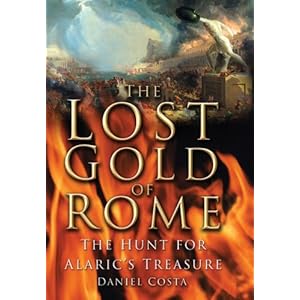Roald Dahl (1997)The Mildenhall Treasure
Rating: 




During the last years of the Roman presence in Britain, in the late third and early fourth centuries, evidence in the form of buried treasures gives a picture of troubled  times. A wealthy family living near Mildenhall in Suffolk, presumably at a time of panic, and intending to retrieve it later, buried a hoard of silver treasure for safety. It could have course already been stolen, and buried with similar intent.
times. A wealthy family living near Mildenhall in Suffolk, presumably at a time of panic, and intending to retrieve it later, buried a hoard of silver treasure for safety. It could have course already been stolen, and buried with similar intent.
Sixteen centuries later, during the Second World War, a ploughman, Gordon Butcher, set his plough four inches deeper than usual. He was on the lookout for coins, for this land had often produced them. He struck some encrusted metal objects which he gave to his employer, Arthur Ford. They returned to the field, retrieving more items.
In 1946, an inquest declared the find to be treasure trove, and their true significance came to light. The Mildenhall treasure is probably the most important collection of Roman works of art ever to be found in Britain. It consists of 34 pieces of highly ornamented silverware, priceless in value, with a total weight of about 25 ½ kilos. When cleaned, the pieces were found to be in an almost perfect state of preservation, made of the finest quality of silver, dating from the fourth century AD to perhaps as early as the first century, which assuming it was part of one collection at the time of burial, represents a collection accumulated over a considerable length of time.
The centrepiece, discovered 25 metres from the remains of a fourth century Roman building, is a magnificent dish, two foot in diameter, and weighing 8 ¼ kilos. A relief shows the head of Oceanus, god of the sea, in the centre, with sea monsters surrounding him. Much of the decoration relates to Bacchus, Pan and female companions, common motifs on silverware of the Roman period. Other pieces of the treasure include a circular niello dish, two convex platters, goblets, a fine bowl with a lid, and eight spoons, five of which are of the kind that may have been used as christening gifts, with the Chi-rho symbol inscribed on the handles, and two with the names Pascentia and Papittedo. Altogether, the hoard forms a curious mixture of pagan and Christian elements. It is thought most of the treasures were either made in Rome or Gaul, but some items, such as the fluted bowl, may have been worked in Britain..
weighing 8 ¼ kilos. A relief shows the head of Oceanus, god of the sea, in the centre, with sea monsters surrounding him. Much of the decoration relates to Bacchus, Pan and female companions, common motifs on silverware of the Roman period. Other pieces of the treasure include a circular niello dish, two convex platters, goblets, a fine bowl with a lid, and eight spoons, five of which are of the kind that may have been used as christening gifts, with the Chi-rho symbol inscribed on the handles, and two with the names Pascentia and Papittedo. Altogether, the hoard forms a curious mixture of pagan and Christian elements. It is thought most of the treasures were either made in Rome or Gaul, but some items, such as the fluted bowl, may have been worked in Britain..
Continue reading The Mildenhall Treasure





 predominance of steel hull and diesel engine, traditional wooden hulled sailing craft remain. The men who sail them represent more than the physical accomplishments of fishing, trading and transporting goods and passengers in some remote and inhospitable locations.
predominance of steel hull and diesel engine, traditional wooden hulled sailing craft remain. The men who sail them represent more than the physical accomplishments of fishing, trading and transporting goods and passengers in some remote and inhospitable locations.











